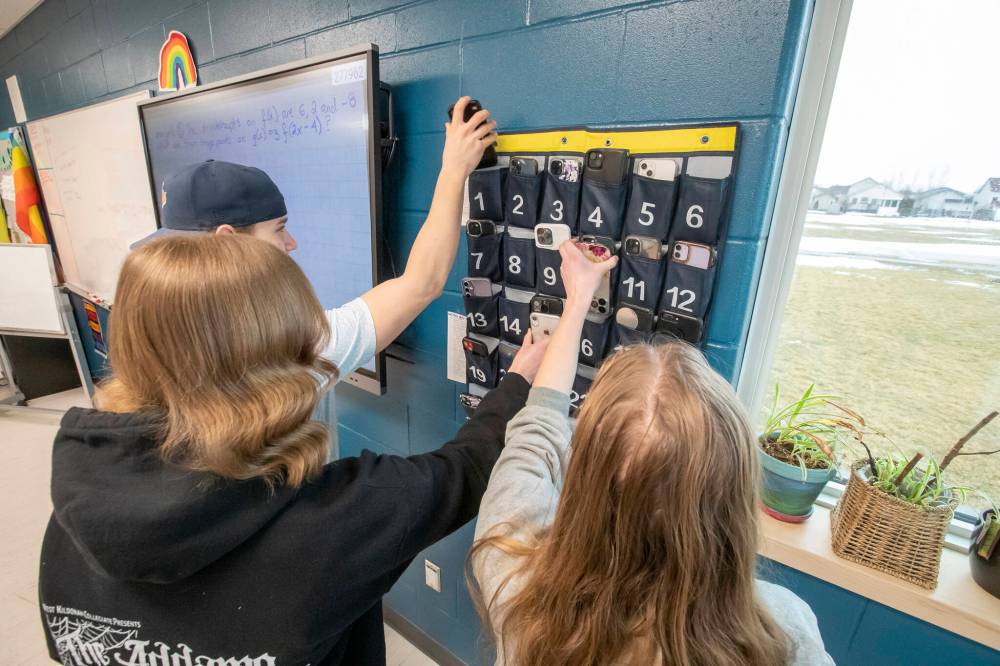Cellphones and classrooms — tool versus distraction
Advertisement
Read this article for free:
or
Already have an account? Log in here »
To continue reading, please subscribe:
Monthly Digital Subscription
$0 for the first 4 weeks*
- Enjoy unlimited reading on winnipegfreepress.com
- Read the E-Edition, our digital replica newspaper
- Access News Break, our award-winning app
- Play interactive puzzles
*No charge for 4 weeks then price increases to the regular rate of $19.00 plus GST every four weeks. Offer available to new and qualified returning subscribers only. Cancel any time.
Monthly Digital Subscription
$4.75/week*
- Enjoy unlimited reading on winnipegfreepress.com
- Read the E-Edition, our digital replica newspaper
- Access News Break, our award-winning app
- Play interactive puzzles
*Billed as $19 plus GST every four weeks. Cancel any time.
To continue reading, please subscribe:
Add Free Press access to your Brandon Sun subscription for only an additional
$1 for the first 4 weeks*
*Your next subscription payment will increase by $1.00 and you will be charged $16.99 plus GST for four weeks. After four weeks, your payment will increase to $23.99 plus GST every four weeks.
Read unlimited articles for free today:
or
Already have an account? Log in here »
Hey there, time traveller!
This article was published 12/02/2024 (675 days ago), so information in it may no longer be current.
Smartphones are a marvel of the modern age.
Not only do they allow us to communicate instantaneously with each other in myriad ways, they provide access to the internet and all of the information contained within it.
The tap of a finger can take us down an educational rabbit hole about human history, mathematics, literature or science.

BROOK JONES / WINNIPEG FREE PRESS
Grade 12 students put their phones in a storage pouch fastened to the wall at West Kildonan Collegiate.
We can tune into videos about philosophy, we can listen to lectures about astronomy.
We can, but do we?
For most people, the supercomputer stashed in their pocket is mainly a communication device with a side of distraction. They’re a useful part of daily life and a fixture of downtime, filled with entertaining games and engaging social media apps.
As with any form of technology, cellphones come with virtues and deficiencies.
For the generations currently moving through the school system, smartphones have been a natural part of their environment from the moment they were born. They grew up with parents who used them freely and frequently and likely inherited their own device at a young age.
This has created a wave of tech-savvy individuals and a growing dilemma in the education field.
More local schools are cracking down on cell use in the classroom in an effort to improve student engagement and cut down on distractions.
Last fall, Division scolaire franco-manitobaine enacted a full-out ban on personal devices during lessons in its schools across the province. Students are expected to leave their phones in their lockers or slip them into classroom storage pouches before sitting down at their desks to learn.
Several months in, leaders within the francophone division are heralding the experiment as a success and three elementary and high schools in Winnipeg are introducing their own cell policies.
It’s a positive trend that should be adopted by more school communities.
This isn’t the first time personal devices have clashed with classroom priorities. In the ’90s, Tamagotchis — egg-shaped toys that contained virtual pets — were the bane of many a teacher’s existence. Some Canadian schools considered banning the toys due to the distraction the pixelated animals presented to students at the height of the fad.
However, unlike Tamagotchis, smartphones aren’t a passing craze. If anything, they’re becoming more ingrained in our lives, for better and for worse.
With effective cellphone policies, educators can regain control of their classroom while offering students an important lesson on the pitfalls of technology.
Most mobile apps are designed to be addictive in order to attract advertisers. Research on the topic of smartphone addiction indicates that the excessive use of these devices can lead to depression, anxiety and poor physical health. These effects can be particularly harmful for adolescents.
While some argue cellphone bans infringe on individual rights, the cost-benefit analysis needs to consider the whole picture. There’s a lot at stake here when it comes to learning outcomes and student wellbeing.
More schools should adopt classroom phone bans, but these prohibitions should also come with curricula about the impact of technology on human beings and teaching around safe usage.
With the necessary context, perhaps students will be more inclined to think critically about their own relationship with smartphones beyond the seven hours per day they spend in school.
Modern classrooms need to harness technology in order to prepare pupils for the increasingly tech-centric world we live in. That also means fostering a sense of responsible and healthy digital citizenship.
History
Updated on Monday, February 12, 2024 6:43 AM CST: Adds photo


